This article needs additional citations for verification .(December 2009) |

Cornwall played a significant role in the English Civil War, being a Royalist enclave in the generally Parliamentarian south-west.
This article needs additional citations for verification .(December 2009) |

Cornwall played a significant role in the English Civil War, being a Royalist enclave in the generally Parliamentarian south-west.
The English Civil War lasted nearly nine years, having begun with the battle of Edgehill, in Warwickshire, on Sunday, 23 October 1642, and ended with the battle of Worcester, on 3 September 1651. The principal events in Cornwall happened in the following order.
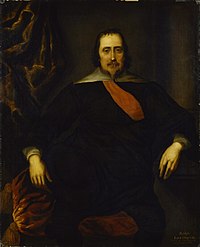
In October 1642, Cornwall was secured for the king when some 10,000 men rose under the command of the local Royalist gentry and drove out the small force of Cornish Parliamentarians who had gathered at Launceston. [1] [2] The Cornish-Royalist Army was formed by Sir Ralph Hopton in 1642 and although their first invasion of Devon in November – December 1642 ended in failure the army secured the Cornish side of Plymouth Sound which marked a serious reverse for Parliamentarian forces.
The Battle of Braddock Down near Boconnoc on 19 January 1643 resulted from a parliamentarian counter-invasion of Cornwall. It ended in defeat for Col. Ruthin's Parliamentarian troops by Sir Ralph Hopton. Hopton's victory secured Cornwall for the King and the Royalists resumed the siege of Plymouth with their forces occupying surrounding towns to seal off the city by land. [3] [4]
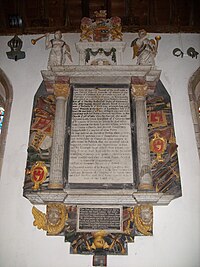
The Battle of Stratton occurred on 15 May 1643. The Earl of Stamford's Parliamentarian force was repelled by Hopton's men after day-long fighting, with 300 men killed and 1700 captured, and retreated to Bideford. The victories for Hopton with five 'Old Cornish' regiments provided the impetus for campaigns in Devon and Somerset. [5] Taunton and Bridgwater were taken by the Cornish army, but Sir Bevil Grenville was killed in the moment of victory at the Battle of Lansdown in Somerset and Hopton was seriously wounded. Bristol fell to Hopton's Royalist troops, followed by Exeter. [6] [7]
On 13 December the Royalists began a heavy bombardment of the northern defences of Plymouth but with little effect. Sir Richard Grenville, 1st Baronet, having previously declared for Parliament, invited his troops to follow him into the King's service and parliament proclaimed him a traitor.
Sir Richard Grenville arrived in Plymouth in March 1644 to maintain a blockade, but it resulted in a stalemate as the inhabitants obtained enough provisions to survive. Robert Devereux, 3rd Earl of Essex, arrived in command of the Roundhead army of 8000 men and forced Grenville to retreat to Cornwall across the River Tamar.

In June 1644 the Earl of Essex took an army of 9,500 to the South-West and successively ended Royalist sieges at Lyme and Plymouth without firing a shot. With such successes, Essex advanced into Cornwall on 26 July believing that with local support he would be able to take control away from the Royalists. On that very same day, however, King Charles, arrived in Exeter intent upon hunting down and destroying Essex’s force. Slowly and deliberately King Charles continued west growing his army to a strength of 19,000 by linking up with the Royalist armies of Prince Maurice and Richard Grenville. Given the size of the King’s army, Essex found himself trapped on the peninsula with the only means of escape by sea. [8]
Essex quickly moved his army to the small town of Lostwithiel, approximately nine kilometers north of the port at Fowey. By 13 August King Charles and his army reached Lostwithiel and eight days later the Royalists attacked easily taking the high ground to the north and east of Lostwithiel away from Essex’s forces. In an untenable position, Essex moved to escape on 31 August first ordering his cavalry to cross the River Fowey and flee to Plymouth which they did successfully. Essex then attempted to retreat to Fowey with his infantry. King Charles had been forewarned of Essex’s plan, however, and immediately pursued the Parliamentarians. The resulting battle began at 07:00 hours and continued for eleven hours as Essex tried to disengage and move south while King Charles continued his pursuit. [8] [9]
At 18:00 hours the Royalists had flanked the Parliamentarians and surrounded them at Castle Dore approximately four kilometers north of Fowey. At this point the Royalist stopped the attack for the day while the Parliamentarians hunkered down beaten and exhausted. Without a chance of reaching Fowey with his infantry, Essex and his command staff stole away during the night to the seashore where they used a fishing boat to escape to Plymouth. On 2 September, Philip Skippon, commander of the Parliamentarian infantry surrendered. The Royalists took 6,000 Parliamentarians as prisoners allowing them to return to Southampton after being disarmed. [8] [10]
The Battle of Lostwithiel was a great victory for King Charles and the greatest loss that the Parliamentarians would suffer in the First English Civil War. For King Charles the victory secured the South-West for the remainder of the war and mitigated criticism for a while against the Royalist war effort. [8] For the Parliamentarians, the defeat resulted in recriminations with Sir John Middleton ultimately being blamed for his failure to break-through with reinforcements. The Parliamentarian failure at Lostwithiel along with the failure to defeat King Charles at the Second Battle of Newbury ultimately led Parliament to adopt the Self-denying Ordinance and led to the implementation of the New Model Army. [11]
In 1645 Sir Thomas Fairfax was appointed the commander of the New Model Army. The Royalist army was also reorganised with Prince Charles becoming the Commander-in-Chief. The Royalists suffered a notable loss at the Battle of Naseby in Northamptonshire and there were further Parliamentarian gains in the south and west of England. Prince Charles, the war being mainly in the eastern counties, spent a great part of the autumn and winter in Cornwall, principally at Launceston and Truro. Sir Richard Grenville was committed by the Prince to Launceston Prison, for refusing to obey Lord Hopton: he had already quarrelled with General George Goring. [12]
In 1646 the Prince gave Lord Hopton command of the Royalist forces, with William Wentworth, 2nd Earl of Strafford to command the horse and Grenville the foot. Grenville refused and was imprisoned on St Michael's Mount. Hopton advanced from Stratton towards Exeter, reaching Torrington but was confronted by Fairfax's men, and fell back to Stratton. The Roundheads proceeded into Cornwall reaching Launceston on 25 February 1646 and Bodmin on 2 March. Hopton's army was in disarray but he refused to surrender. News at Bodmin of an imminent Irish invasion further damaged the Royalist cause locally and Fairfax offered Hopton terms. The surrender took place at Tresillian Bridge, near Truro, on 15 March 1646.
The Gear Rout was a Cornish insurrection of 1648 following the end of the First English Civil War. The killing of 70 Cornish Royalists in Penzance on 16 May 1648 prompted a failed rebellion by some 500 Cornish rebels who fought against the Parliamentarian forces of Sir Hardress Waller at a site near the Helford River. [13]

The Battle of Lostwithiel took place over a 13-day period from 21 August to 2 September 1644, around the town of Lostwithiel and along the River Fowey valley in Cornwall during the First English Civil War. A Royalist army led by Charles I of England defeated a Parliamentarian force commanded by the Earl of Essex.

The sieges of Taunton were a series of three blockades during the First English Civil War. The town of Taunton, in Somerset, was considered to be of strategic importance because it controlled the main road from Bristol to Devon and Cornwall. Robert Blake commanded the town's Parliamentarian defences during all three sieges, from September 1644 to July 1645.
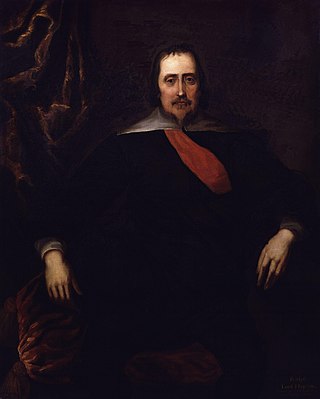
Ralph Hopton, 1st Baron Hopton was an English politician, military officer and peer. During the First English Civil War, he served as Royalist commander in the West Country, and was made Baron Hopton of Stratton in 1643.
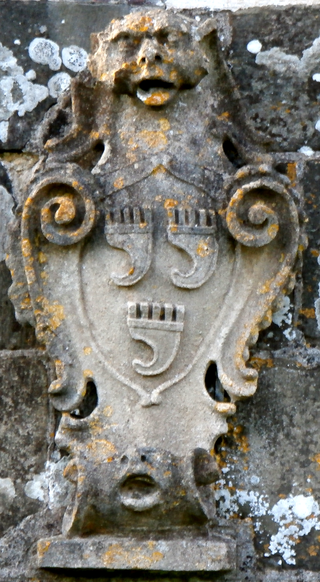
Sir Richard Grenville was a professional soldier from Cornwall, who served in the Thirty Years War, and 1638 to 1651 Wars of the Three Kingdoms. He was the younger brother of Sir Bevil Grenville, who died at Lansdowne in 1643, and grandson of Admiral Sir Richard, killed at Flores in 1591.

Lostwithiel is a civil parish and small town in Cornwall, England, United Kingdom at the head of the estuary of the River Fowey. According to the 2001 census it had a population of 2,739, increasing to 2,899 at the 2011 census. The Lostwithiel electoral ward had a population of 4,639 at the 2011 census. The name Lostwithiel comes from the Cornish "lostwydhyel" which means "tail of a wooded area".

Sir Bevil Grenville was an English landowner and soldier who sat as a Member of Parliament for various constituencies between 1620 and 1642, although during those years there were few parliamentary sessions. When the First English Civil War broke out in August 1642, he joined the Royalists and played a leading role in their early campaigns in the West Country. He was killed in action at the Battle of Lansdowne in 1643.

The Battle of Cheriton of 29 March 1644 was an important Parliamentarian victory during the First English Civil War. Sir William Waller's "Army of the Southern Association" defeated a Royalist force jointly commanded by the Earl of Forth and Sir Ralph Hopton. Defeat ended Royalist hopes of retaking South East England and forced them onto the defensive for the rest of 1644.

Braddock is a village and civil parish in Cornwall, England, United Kingdom. The village is about seven miles west of Liskeard, and five miles south-east of Bodmin. The parish was called Broadoak until 1 April 2021.
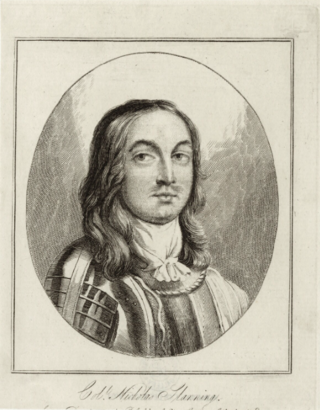
Sir Nicholas Slanning was a soldier and landowner from Devon who sat in the House of Commons from 1640 to 1642. He served in the Royalist army during the First English Civil War and was mortally wounded at Bristol on 26 July 1643.

The battle of Sourton Down was a successful Parliamentarian ambush at Sourton Down, in South West England, on 25 April 1643, during the First English Civil War. After a failed attack on Royalist-held Launceston, the Parliamentarians fell back to their base at Okehampton, pursued by a Royalist army under Sir Ralph Hopton, who marched overnight, planning to attack the town at dawn.

The New Cornish Tertia were four Royalist regiments of infantry raised in Cornwall and Devon by Sir Richard Grenville, 1st Baronet in 1644, during the English Civil War. As the maps aside show, Cornwall and Wales were staunch Royalist strongholds whilst South East England was held by Parliament, and the remainder of England was in dispute.

The Battle of Braddock Down was a battle of the south-western campaign of the First English Civil War. It was fought on open ground in Cornwall, on 19 January 1643. An apparently easy victory for the Royalists under Sir Ralph Hopton secured Cornwall for King Charles and confirmed Hopton's reputation as a commander. Hopton also gained respect for the mercy shown to his foe, of whom 1,500 were captured during and after the battle. The precise location of the battlefield is a matter of dispute, though English Heritage believe it to be within parkland at Boconnoc.

The Battle of Stratton, also known as the Battle of Stamford Hill, took place on 16 May 1643, at Stratton in Cornwall, during the First English Civil War. In the battle the Royalists destroyed Parliament's field army in Devon and Cornwall.

Sir Alexander Carew was an English landowner, soldier and politician from Antony, Cornwall. Elected Member of Parliament for Cornwall in November 1640, he voted for the execution of the Earl of Strafford in May 1641, and supported the removal of bishops from the Church of England.
Sir William Godolphin was an English soldier and politician who sat in the House of Commons in 1640. He fought for the Royalist cause in the English Civil War.

Colonel James Chudleigh was an English military officer, who served in the First English Civil War. Initially appointed to command the Parliamentarian garrison at Barnstaple, he showed considerable ability, and was quickly promoted.

The siege of Plymouth took place during the First English Civil War, when Royalist forces besieged Plymouth, in Devon, held by a Parliamentary garrison.


The Battle of Gunnislake New Bridge was a battle that took place on 20 July 1644 on and around Gunnislake New Bridge, a bridge over the River Tamar between Cornwall and Devon, during the First English Civil War.
{{cite journal}}: Cite journal requires |journal= (help)